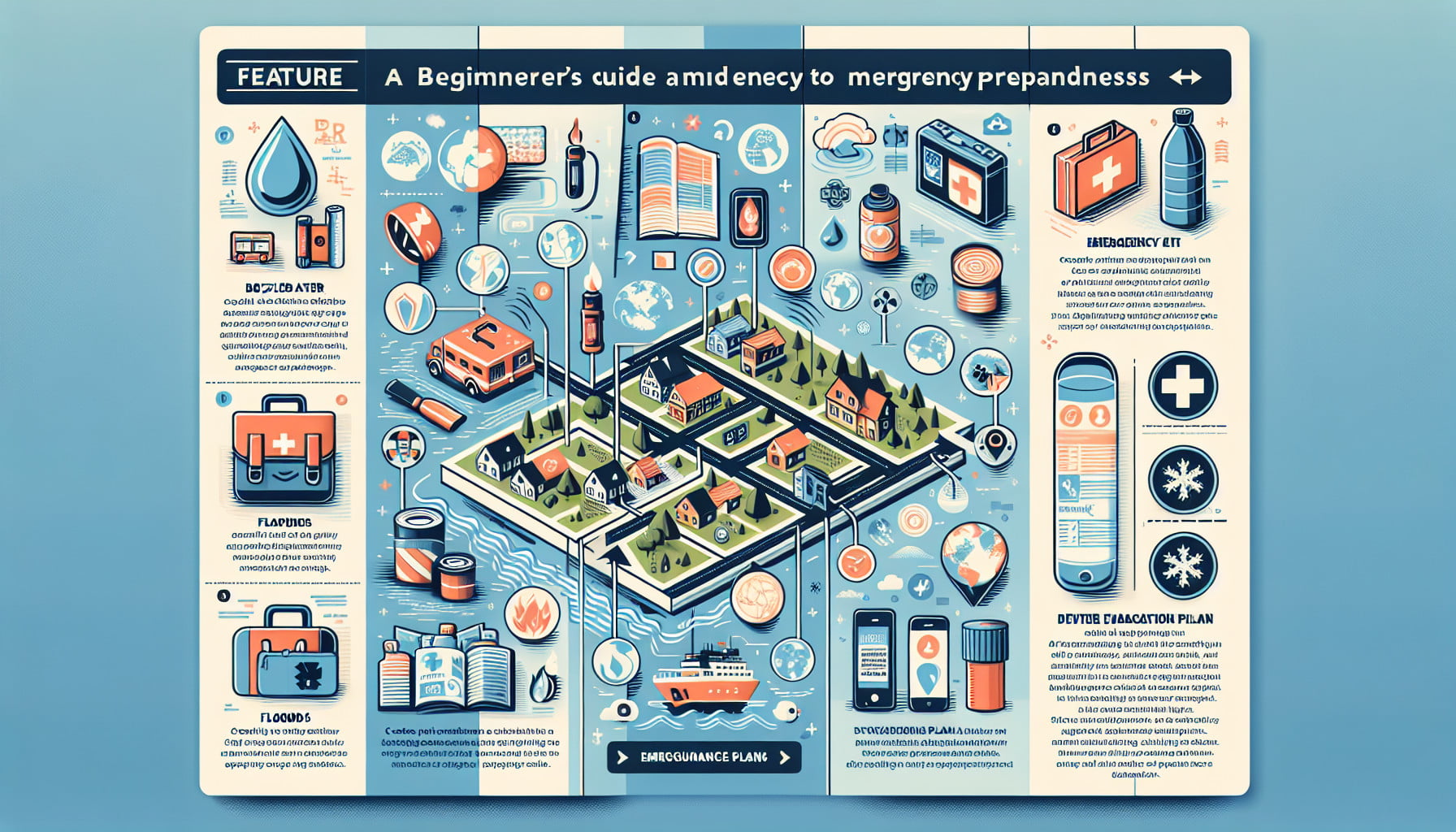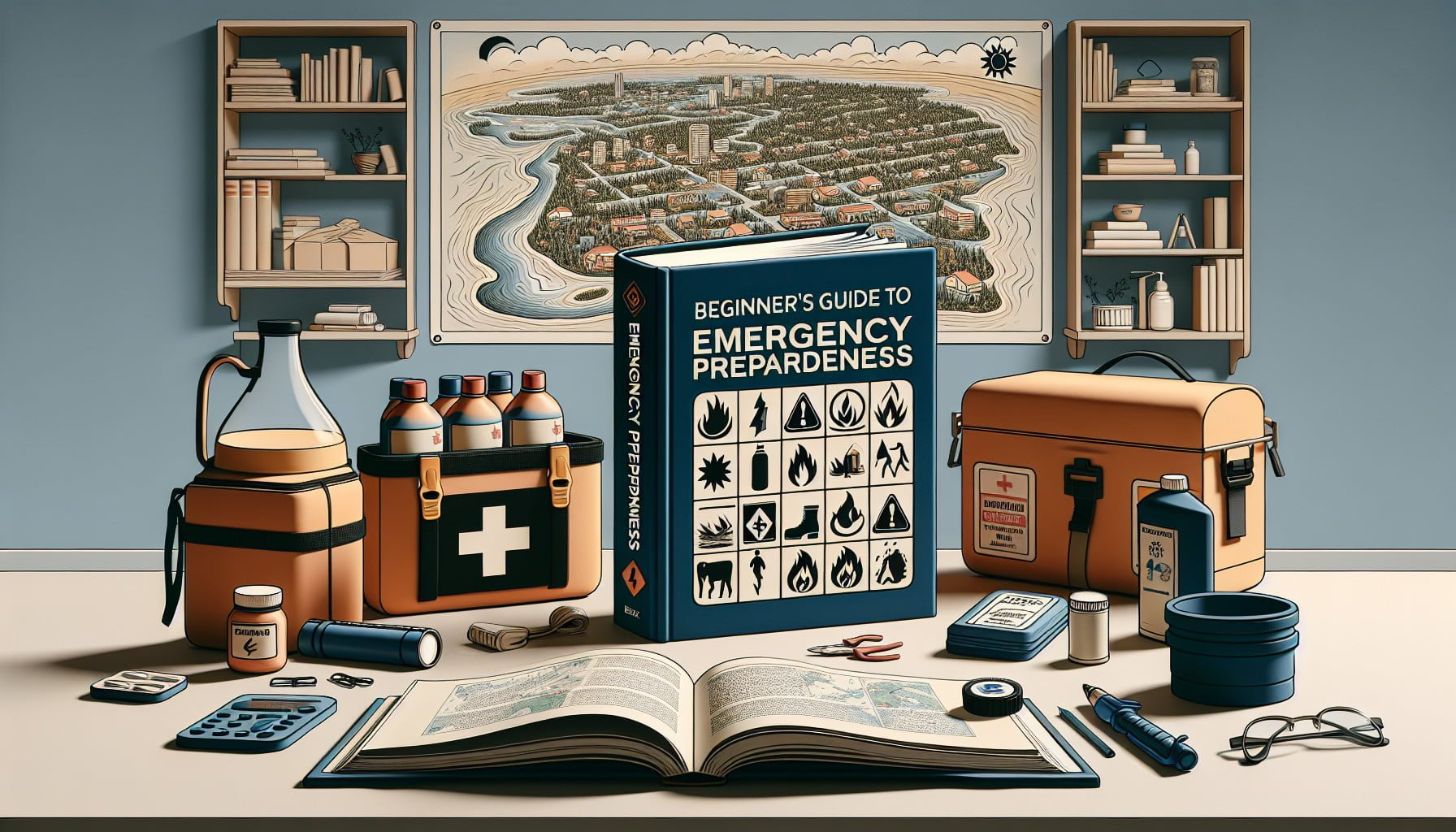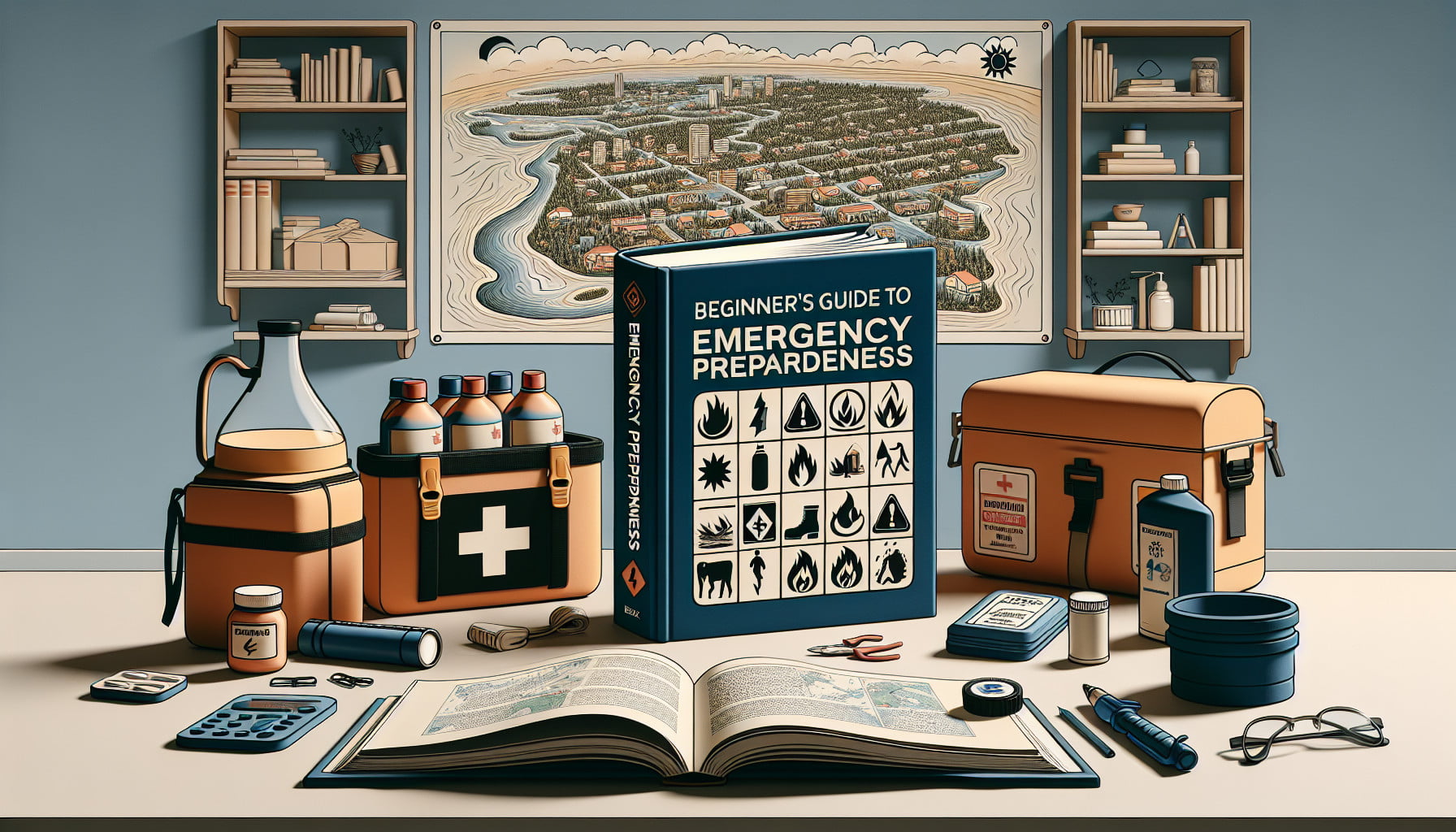So you’ve decided to take the first step towards being prepared for emergencies? Great! In this Beginner’s Guide to Emergency Preparedness, you’ll find all the essential information you need to ensure your safety and well-being in various unforeseen situations. From natural disasters to power outages, we’ll cover the basics of creating a comprehensive emergency plan, assembling a well-stocked emergency kit, and developing essential skills to help you navigate through challenging times. Don’t worry if you’re new to this, we’ve got your back! Let’s get started.

Understanding Emergency Preparedness
What is emergency preparedness?
Emergency preparedness refers to the actions and measures taken to ensure individuals and communities are ready to respond to and recover from emergencies or disasters. It involves being aware of potential risks, planning ahead, and gathering the necessary resources and knowledge to effectively handle a crisis situation. By having a thorough emergency preparedness plan in place, you can minimize the impact of emergencies, protect yourself and your loved ones, and aid in the swift recovery process.
The importance of emergency preparedness
Emergency preparedness is crucial because it allows you to minimize the negative impacts of emergencies and increase your chances of safety and survival. Whether it’s a natural disaster, a medical emergency, or a man-made crisis, being prepared can make all the difference. By having a well-thought-out emergency plan, you can reduce panic and confusion, make informed decisions, and take timely actions to protect yourself and others.
Common types of emergencies
Emergencies can come in various forms, and it’s essential to be aware of the common types in order to adequately prepare for them. Some of the most common emergencies include natural disasters such as hurricanes, earthquakes, floods, and wildfires. Other emergencies include medical crises like heart attacks or injuries, civil disturbances, power outages, and even terrorist attacks. Each type of emergency requires specific considerations and preparations, highlighting the importance of being well-informed and ready for any situation.
Creating an Emergency Plan
Assessing potential risks
To create an effective emergency plan, you must first assess the potential risks specific to your geographical location and individual circumstances. Consider the types of emergencies that are most likely to occur in your area, such as hurricanes in coastal regions or earthquakes in seismic zones. You should also evaluate your personal situation, taking into account factors like your health, age, and any special needs or vulnerabilities. By understanding the risks, you can tailor your emergency plan to address them accurately.
Identifying evacuation routes
Evacuation routes are critical during emergencies that require you to leave your home quickly. Familiarize yourself with the evacuation routes in your community and establish multiple alternatives in case your primary route is compromised. Pay attention to local authorities and emergency management agencies for updates on designated evacuation routes during specific emergencies. Remember to include provisions for pets or livestock in your evacuation plans, as they may require special accommodations.
Establishing communication methods
During an emergency, communication is vital for staying informed and coordinating with others. Establish multiple communication methods to ensure you can effectively reach out to family members, friends, and emergency services. Make sure you have a designated meeting place where everyone in your household can gather if you become separated. Additionally, consider alternative methods of communication, such as two-way radios or messaging apps that work without relying on cellular networks.
Building an Emergency Kit
Essential items for an emergency kit
Building an emergency kit is one of the pillars of preparedness. Your emergency kit should include essential items that can sustain you and your family during an emergency. These items may include:
- Non-perishable food that requires no cooking or refrigeration
- Bottled water (one gallon per person per day)
- Flashlights and extra batteries
- First aid supplies
- Prescription medications
- Personal hygiene items
- Cash or emergency funds
- Multi-tool or Swiss Army knife
- Blankets and warm clothing
- Whistle for signaling
- Copies of important documents (identification, insurance policies, etc.)
Stocking up on food and water
A key component of your emergency kit is having an ample supply of food and water. Aim to have at least three days’ worth of non-perishable food for each person in your household. Canned goods, energy bars, and dried fruits are excellent options. Remember to rotate your food supply periodically to ensure freshness. In terms of water, store at least one gallon per person per day for drinking and sanitation purposes. Consider purchasing water purification tablets or a reliable water filter to remove contaminants in case your water supply is compromised.
Including important documents and medication
In addition to food and water, it is crucial to include important documents and medications in your emergency kit. Make copies of essential documents such as identification cards, passports, insurance policies, and medical records. Keep these copies in a waterproof and portable container within your emergency kit to ensure they are easily accessible during an evacuation. Don’t forget to include an up-to-date list of medications and any necessary medical supplies that you or your family members may need.
Securing Your Home
Securing doors and windows
Securing your home is essential to protect against potential threats and intrusions during emergencies. Reinforce doors and install deadbolt locks to make them more resistant to forced entry. Consider installing window security film or laminated glass to protect against break-ins or flying debris during severe weather events. Use security bars or grilles on windows and ensure they have a quick-release feature for emergency escape. Regularly inspect the condition of doors and windows to identify any vulnerabilities that need to be addressed.
Protecting against extreme weather
Extreme weather events, such as hurricanes, tornadoes, or severe storms, can pose significant risks to your home and personal safety. Take preventive measures to protect your property, such as reinforcing the roof and anchoring outdoor structures like sheds or gazebos. Install storm shutters or impact-resistant windows to shield against high winds and flying debris. Trim tree branches that could potentially fall and cause damage, and secure loose outdoor items that could become airborne projectiles during a storm.
Preventing fires and accidents
Fires and accidents can occur during emergencies, and taking precautions to prevent them is essential. Install smoke detectors on each level of your home, and regularly test and replace their batteries. Keep fire extinguishers in easily accessible areas and learn how to use them properly. Maintain proper electrical wiring and be cautious with the use of candles or alternative heat sources during power outages. Establish and practice a fire escape plan, ensuring all family members know the evacuation routes and meeting points.

Emergency Communication
Establishing a communication plan
During emergencies, communication can become challenging, making it imperative to establish a communication plan in advance. Determine a designated out-of-state contact who can act as a central point of communication for all family members. Share this contact’s information with each family member, and ensure everyone knows when and how to reach out in case of separation. Create a plan for checking in with each other periodically and establish a designated meeting place if communication channels are disrupted.
Using emergency radios and phones
In situations where cellular networks may be down or overloaded, it’s crucial to have alternative communication methods, such as emergency radios. Invest in a hand-crank or battery-operated radio that can receive emergency broadcasts and weather updates. Additionally, consider having a backup power source, like a portable charger or a power bank, to keep your mobile devices operational during extended power outages. Save emergency contact numbers in your phone, as well as on paper, in case you need to contact emergency services without your device.
Keeping emergency contact information
Having access to emergency contact information is vital for immediate assistance during a crisis. Make a list of important contact numbers, including local emergency services, family members, neighbors, and medical professionals. Store this information in your emergency kit, on your mobile devices, and keep a printed copy in a safe, easily accessible location. Also, consider downloading relevant emergency preparedness apps that can provide additional information and assistance during different types of emergencies.
First Aid and Medical Preparedness
Learning basic first aid skills
Having basic first aid skills can be invaluable during emergencies when professional medical help may not be readily available. Consider taking a certified first aid or CPR course to learn essential skills like administering CPR, treating wounds, or performing the Heimlich maneuver. You can find these courses through local community centers, medical organizations, or online platforms. By arming yourself with knowledge, you’ll be better prepared to provide immediate assistance to injured individuals until professional help arrives.
Assembling a first aid kit
A well-stocked first aid kit is an essential component of any emergency preparedness plan. Ensure your first aid kit includes the basics, such as adhesive bandages, sterile gauze pads, antiseptic wipes, scissors, tweezers, and disposable gloves. Consider including additional supplies like a thermometer, pain relievers, allergy medication, and any personal prescription medications. Keep your first aid kit in an easily accessible location and regularly check its contents, replacing any expired or used items.
Preparing for medical emergencies
While some emergencies can be addressed with basic first aid, others may require more specialized medical attention. Familiarize yourself with the location of nearby hospitals, urgent care centers, and specialized medical facilities. Make note of their contact information and the best route to reach them during emergencies. Additionally, consider having a backup supply of necessary prescription medications and medical supplies to last for an extended period in case access to pharmacies or medical services becomes limited.
Emergency Shelter and Evacuation
Identifying local shelters
In certain emergencies, it may be necessary to evacuate and seek shelter in designated facilities. Research and identify the local shelters in your area, such as community centers, schools, or designated evacuation centers. Be aware of any specific requirements or restrictions these shelters may have, such as pet policies or accessibility considerations. Stay informed through local news sources or emergency management agencies to receive updates on shelter availability and recommended evacuation routes.
Creating an evacuation plan
Developing a detailed evacuation plan is essential to ensure a safe and organized departure from your home during emergencies. Consider different scenarios and determine the quickest and safest evacuation routes, taking into account potential road closures or traffic congestion. Plan for multiple ways to leave your neighborhood and establish meeting points outside your immediate area in case family members become separated. Practice your evacuation plan regularly to familiarize everyone with the process and identify any potential obstacles or improvements.
Packing essential items for evacuation
When evacuating, it’s essential to have a “go bag” or an emergency backpack ready with essential items. Include items such as spare clothing, sturdy shoes, medications, important documents, cash, and personal hygiene items. If you have pets, pack their necessities like food, water, medications, and bedding. For individuals with special needs or medical conditions, ensure you have the necessary supplies or equipment to meet their unique requirements. Keep your go bag in an easily accessible location and periodically check and replace its contents as needed.
Emergency Financial Preparedness
Setting up emergency funds
Financial preparedness is often overlooked but can greatly impact your ability to recover from an emergency. Start by setting up an emergency fund that can cover at least three to six months’ worth of living expenses. This fund can help you navigate unexpected costs, such as temporary relocation or necessary repairs. Regularly contribute to this fund and resist the temptation to use it for non-emergency expenses. Having financial security can provide peace of mind and support your recovery efforts during and after an emergency.
Organizing important financial documents
To streamline recovery processes and ensure access to necessary funds, organize and secure important financial documents in a safe location. This includes identification documents, insurance policies, bank account information, property deeds, and vehicle titles. Make digital copies of these documents and store them in a password-protected cloud storage or on secure external drives. Keep physical copies in a fireproof and waterproof container within your home. Regularly review and update these documents as needed.
Planning for insurance coverage
Insurance coverage plays a critical role in financial preparedness for emergencies. Review your insurance policies and ensure they provide adequate coverage for potential risks in your area, such as flood insurance for flood-prone regions or additional coverage for high-value items. Understand the terms and conditions of your policies, including deductibles and coverage limitations. Consider consulting with an insurance professional to ensure comprehensive coverage and to address any gaps or potential areas for improvement.
Psychological Preparedness
Understanding the psychological impact of emergencies
In addition to physical safety, it is essential to acknowledge and address the psychological impact of emergencies. Disasters and crises can be traumatizing, leading to stress, anxiety, and emotional distress. Understand that experiencing these responses is normal and part of the recovery process. Learn about the psychological impact of emergencies, such as post-traumatic stress disorder (PTSD), and be aware of the signs and symptoms in yourself and loved ones. By recognizing the importance of psychological preparedness, you can better support your mental well-being during and after emergencies.
Developing coping strategies
Coping with the emotional toll of emergencies requires effective strategies and support systems. Find healthy ways to manage stress, such as practicing relaxation techniques, engaging in physical activity, or pursuing hobbies that bring you joy. Seek support from friends, family, or professional counselors who can provide guidance and a listening ear. Maintain a routine and establish a sense of normalcy as much as possible to aid in emotional recovery. Remember that self-care is essential and prioritize your mental well-being throughout the emergency and recovery process.
Seeking support and assistance
No one should face the aftermath of an emergency alone. Reach out for support and assistance when needed. Local and national organizations, such as the Red Cross or disaster relief agencies, can provide resources, counseling services, and community support during and after emergencies. Connect with community groups or online forums where individuals share similar experiences and provide mutual support. Remember that seeking help is a sign of strength and resilience, and you are not alone in your journey towards recovery.
Reviewing and Practicing Your Plan
Regularly reviewing and updating your plan
Emergency preparedness is an ongoing process, and it is crucial to regularly review and update your plan as circumstances change. Review your emergency plan at least once a year or whenever a significant change occurs in your situation, such as moving to a new area or experiencing a medical condition. Update contact information, revise evacuation routes if needed, and ensure your emergency kit remains stocked and up-to-date. Regularly communicate with your household members to ensure everyone is familiar with the plan and any changes that have been made.
Conducting emergency drills and exercises
Practicing your emergency plan through drills and exercises is an effective way to ensure its effectiveness and identify any areas for improvement. Conduct fire evacuation drills and practice various scenarios, such as sheltering in place during severe weather or performing first aid on a simulated injured person. Time your drills to assess how quickly you can execute your plan and make necessary adjustments. Encourage open communication during these exercises and debrief afterwards to gather feedback and implement improvements.
Seeking feedback and improving your preparedness
Lastly, seek feedback from trusted sources, such as local emergency management agencies or experienced individuals in emergency preparedness. They can provide valuable insights and recommendations to further enhance your preparedness efforts. Engage in community discussions or attend local workshops and seminars related to emergency preparedness to stay informed and learn from others’ experiences. By continuously seeking improvements and learning from others, you can further enhance your preparedness and contribute to building a more resilient community.
In conclusion, understanding emergency preparedness is crucial for minimizing the impact of emergencies, protecting yourself and loved ones, and aiding in the recovery process. By creating an emergency plan, building an emergency kit, securing your home, establishing communication methods, preparing for medical emergencies, identifying shelter and evacuation options, planning for financial security, addressing psychological impacts, and regularly reviewing and practicing your plan, you can significantly increase your readiness and resilience in the face of emergencies. Remember, being well-prepared today can make a significant difference tomorrow. Stay informed, stay prepared, and stay safe.

